Tianwen-1
 TheTianwen-1 orbiter (below) and the capsule housing the lander andZhurongrover(top). | |
| Names | Huo xing-1 (Hoả tinh -1) (2018–2020)[1][2][3] |
|---|---|
| Mission type | Mars exploration |
| Operator | CNSA |
| COSPAR ID | 2020-049A |
| SATCATno. | 45935 |
| Mission duration | |
| Spacecraft properties | |
| Spacecraft |
|
| Manufacturer | CNSA |
| Launch mass | |
| Dimensions | Zhurong:2.6 m × 3 m × 1.85 m (8 ft 6 in × 9 ft 10 in × 6 ft 1 in) |
| Start of mission | |
| Launch date | 23 July 2020, 04:41:15UTC[8] |
| Rocket | Long March 5(Y4) |
| Launch site | WenchangLC-101 |
| Contractor | China Aerospace Science and Technology Corporation |
| Marsorbiter | |
| Spacecraft component | Tianwen-1 Orbiter |
| Orbital insertion | 10 February 2021, 11:52 UTC[9][10] |
| Flyby ofMars | |
| Spacecraft component | Tianwen-1 Deployable Camera 1 (TDC-1) |
| Closest approach | ~10 February 2021 (deployed fromTianwen-1 Orbiter in September 2020)[11] |
| Mars lander | |
| Spacecraft component | Tianwen-1 Lander |
| Landing date | 14 May 2021, 23:18 UTC[12][13][14] MSD 52387 06:38AMT |
| Landing site | Utopia Planitia[15] 25°03′58″N109°55′30″E/ 25.066°N 109.925°E[16][17] |
| Mars rover | |
| Spacecraft component | ZhurongRover |
| Landing date | 14 May 2021, 23:18 UTC (deployed fromTianwen-1 lander on 22 May 2021, 02:40 UTC)[18] |
| Landing site | Utopia Planitia[15] 25°03′58″N109°55′30″E/ 25.066°N 109.925°E[17] |
| Distance driven | 1.921 km (1.194 mi) as of 5 May 2022[update][19] |
| Mars lander | |
| Spacecraft component | Tianwen-1 Remote Camera (TRC) |
| Landing date | 14 May 2021, 23:18 UTC (deployed fromZhurongrover on 1 June 2021 which itself was deployed fromTianwen-1 lander on 22 May 2021, 02:40 UTC)[20] |
| Landing site | Utopia Planitia[15] 25°03′58″N109°55′30″E/ 25.066°N 109.925°E[17] |
| Marsorbiter | |
| Spacecraft component | Tianwen-1 Deployable Camera 2 (TDC-2) |
| Orbital insertion | 10 February 2021, 11:52 UTC (entered orbit with the orbiter but was released fromTianwen-1 Orbiter on 31 December 2021)[21] |
 Planetary Exploration of ChinaMars logo | |
Tianwen-1Chinese:Thiên hỏi nhất hào(also referred to asTW-1;simplified Chinese:ThiênHỏi;traditional Chinese:ThiênHỏi;lit.'Heavenly Questions'') is an interplanetary mission by theChina National Space Administration(CNSA) which sent a robotic spacecraft toMars,consisting of 6 spacecraft: anorbiter,two deployable cameras,lander,remote camera, and theZhurongrover.[22]The spacecraft, with a total mass of nearly five tons, is one of the heaviest probes launched to Mars and carries 14 scientific instruments. It is the first in a series of planned missions undertaken by CNSA as part of itsPlanetary Exploration of Chinaprogram.
The mission's scientific objectives include: investigation of Martiansurface geologyand internal structure, search for indications ofcurrent and past presence of water,and characterization of the space environment and the atmosphere of Mars.
The mission was launched from theWenchang Spacecraft Launch Siteon 23 July 2020[23]on aLong March 5heavy-liftlaunch vehicle.After seven months of transit through the innerSolar System,the spacecraft enteredMartian orbiton 10 February 2021.[24][10]For the next three months the probe studied the target landing sites from a reconnaissance orbit. On 14 May 2021, the lander/rover portion of the mission successfully touched down on Mars,[22]making China thethird nation[25]to make asoft landingon and establish communication from the Martian surface, after the Soviet Union and the United States.[26][a]
On 22 May 2021, theZhurongrover drove onto the Martian surface via the descent ramps on its landing platform.[29][30]With the successful deployment of the rover, China became the second nation to accomplish this feat, after the United States.[4][31][32][33]In addition, China is the second nation to orbit and the first one to carry out landing and rovering mission on Mars successfully on its maiden attempt.[34]Tianwen-1 is also the second mission to capture audio recordings on the Martian surface, after United States'Perseverance rover.The "smallsat" deployed by theZhurongrover on the Martian surface consists of a "drop camera" which photographed both the rover itself as well as theTianwen-1 lander.[35]With a mass of less than 1 kg, theTianwen-1 remote camera is thelightest artificial objecton Mars as of May 2021. On December 31, 2021, theTianwen-1 orbiter deployed a second deployable camera (TDC-2) into Mars orbit which captured photographs of theTianwen-1 in orbit to celebrate its achievement of the year[21]and a selfie stick payload was deployed to its working position on orbiter to take images of the orbiter's components and Chinese flag on 30 January 2022 to celebrate theChinese New Year.In September 2022, the mission was awarded theWorld Space Awardby theInternational Astronautical Federation.[36][37]
TheTianwen-1 mission was the second of three Martian exploration missions launched during theJuly 2020 window,after theUnited Arab Emirates Space Agency'sHopeorbiter, and beforeNASA'sMars 2020mission, which landed thePerseverancerover with the attachedIngenuityhelicopter drone.[38]
Nomenclature[edit]
China's planetary exploration program is officially dubbed the "TianwenSeries "."Tianwen-1"(Chinese:Thiên hỏi nhất hào) is the program's first mission, and subsequent planetary missions will be numbered sequentially.[39]The nameTianwenmeans "questions to heaven" or "quest for heavenly truth", fromthe classical poem of the same namewritten byQu Yuan(c.340–278 BC), an ancient Chinese poet.[40][41]Tianwen-1's rover is namedZhurong(Chinese:Chúc DungHào), aftera Chinese mytho-historical figureusually associated with fire and light.[42]The name was chosen through an online poll held from January to February 2021.[43]
Earlier attempt[edit]
China's Mars program started in partnership with Russia. In November 2011, the Russian spacecraftFobos-Grunt,destined for Mars andPhobos,was launched fromBaikonur Cosmodrome.The Russian spacecraft carried with it an attached secondary spacecraft, theYinghuo-1,which was intended to become China's first Mars orbiter (Fobos-Grunt also carried experiments from theBulgarian Academy of Sciencesand the AmericanPlanetary Society). However, Fobos-Grunt's main propulsion unit failed to boost the Mars-bound stack from its initialEarthparking orbit and the combined multinational spacecraft and experiments eventually reentered theatmosphere of Earthin January 2012.[citation needed]In 2014, China subsequently began an independent Mars project.[44]
Mission overview[edit]
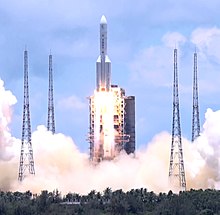
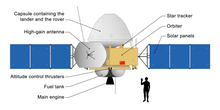

The new Mars spacecraft, consisting of an orbiter and a lander with an attached rover, was developed by theChina Aerospace Science and Technology Corporation(CASC) and is managed by the National Space Science Centre (NSSC) inBeijing.[45]The mission was formally approved in 2016.[46]
On 14 November 2019, CNSA invited some foreign embassies and international organizations to witness hovering and obstacle avoidance test for the Mars Lander of China's first Mars exploration mission at theextraterrestrial celestial landing test site.It was the first public appearance of China's Mars exploration mission.[47]
As the mission preparation proceeded, in April 2020, the mission was formally named "Tianwen-1 ".[48]
On23 July 2020,Tianwen-1 was launched fromWenchang Spacecraft Launch Siteon the island ofHainanatop aLong March 5heavy-lift launch vehicle.[23]

In September 2020, theTianwen-1 orbiter deployed theTianwen-1 First Deployable Camera (TDC-1), a small satellite with two cameras that took photos of and tested a radio connection withTianwen-1.[11]Its mission was to photograph theTianwen-1 orbiter and the lander's heat shield.[11]Due to the time when it was deployed, it trajectory predicted to do a flyby of Mars with that happening around the orbit insertion date.
During its cruise to Mars, the spacecraft completed four trajectory correction maneuvers plus an additional maneuver to alter itsheliocentricorbital inclination; it also performed self diagnostics on multiple payloads.[49][50]After payload checkouts, the spacecraft began scientific operations with the Mars Energetic Particle Analyzer, mounted on the orbiter, which transmitted initial data back to ground control.[51]
The lander/rover portion of the mission began its Martian landing attempt on 14 May 2021. About nine minutes after theaeroshellhousing the lander/rover combination entered the Martian atmosphere, the lander (carrying the rover) safely touched down in theUtopia Planitiaregion on Mars.[52][53][54]After a period spent conducting system checkouts and other planning activities (including taking engineering images of itself), the lander deployed theZhurongrover for independent surface operations.[55]This rover is powered bysolar panelsand will probe the Martian surface with radar and conduct chemical analyses on thesoil;it will also look forbiomoleculesandbiosignatures.[4]
Mission objectives[edit]
This is the CNSA's first interplanetary mission, as well as its first independent probe to Mars. The primary goal is therefore to validateChina's deep space communications and control technologies,as well as the Administration's ability to successfully orbit and land spacecraft.
From a scientific point of view, the mission must meet five objectives:
- Study thegeological structure of Marsand that structure's historical evolution. To do this, the probe will analyze topographical data from characteristic regions such as dry riverbeds, the reliefs ofvolcanoes,glaciers at the poles, areas affected by wind erosion, etc. The two cameras present on the orbiter are dedicated to this objective.
- Study the characteristics of both the surface and underground layers of Martian soil, as well as the distribution of water ice. This is the role of the radars present on the orbiter and the rover.
- Study the composition and type of rocks on the Martian surface, carbonatemineralspresent in ancient lakes, rivers, and other landscapes resulting from the past presence of water on the planet, and weathering mineral such ashematites,lamellarsilicates,sulphatehydratesandperchlorate.Thespectrometerson board the orbiter and the rover as well as the multispectral camera are dedicated to this objective.
- Study theionosphere,the climate,the seasons, and more generallythe atmosphere of Mars,both in its near-space environment and on its surface. This is the role of the twoparticle detectorspresent on the orbiter as well as of the rover'sweather station.
- Study the internal structure of Mars, itsmagnetic field,the history of its geological evolution, the internal distribution of its mass, and its gravitational field. Themagnetometersas well as the radars present on the orbiter and the rover are dedicated to this objective.[56]
The aims of the mission include searching for evidence of current and past life, producing surface maps, characterizing soil composition and water ice distribution, and examining theMartian atmosphere,particularly its ionosphere.[31]
The mission also serves as atechnology demonstrationthat will be needed for an anticipatedMars sample-return missionproposed for the 2030s.[57]Zhurongwill also cache rock and soil samples for retrieval by the later sample-return mission, and the orbiter will make it possible to locate a caching site.[58]
Mission planning[edit]

In late 2019, the Xi'an Aerospace Propulsion Institute, a subsidiary of CASC, stated that the performance and control of the future spacecraft's propulsion system has been verified and had passed all requisite pre-flight tests, including tests for hovering, hazard avoidance, deceleration and landing. The main component of the lander's propulsion system consists of a single engine that provides 7,500 N (1,700 lbf) of thrust. The spacecraft's supersonic parachute system had also been successfully tested.[46]
CNSAinitially focused on theChryse PlanitiaandElysium Monsregions of Mars in its search for possible landing sites. However, in September 2019 during a joint meeting inGeneva,in Switzerland, of the European Planetary Science Congress-Division for Planetary Sciences, the presenters announced that two preliminary sites in theUtopia Planitiaregion of Mars have instead been chosen for the anticipated landing attempt, with each site having a landing ellipse of approximately 100 by 40 kilometres.[46]
In July 2020, CNSA provided landing coordinates of 110.318° Eastlongitudeand 24.748° Northlatitude,within the southern portion ofUtopia Planitia,as the specific primary landing site. The area was chosen for being both of scientific interest and being safe enough for landing attempts.[15][17]Simulated landings have been performed as part of mission preparations by the Beijing Institute of Space Mechanics and Electricity.[59]
By 23 January 2020, theLong March 5Y4 rocket's hydrogen-oxygen engine had completed a 100-seconds test, which was the last engine test prior to the final assembly of the launch vehicle. It successfully launched on 23 July 2020.[23]
Entering Mars orbit[edit]
The threeTianwen-1 spacecraft were launched byLong March 5Heavy-lift launch vehicleon 23 July 2020. Having traveled for about seven months, it entered Marsorbiton 10 February 2021 by performing a burn of its engines to slow down just enough to be captured byMars' gravitational pull.The orbiter spent several months scanning and imaging the surface of Mars to refine the target landing zone for the lander/rover.[60][61][41]It approached at about 265 km (165 mi) (periareion,orperiapse) to Mars' surface, allowing a high-resolution camera to return images to Earth and to map the landing site inUtopia Planitia,and to prepare for landing.[50]
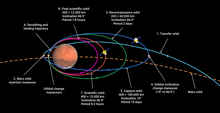
Orbital elements[edit]
| Parameter | Value (unit) |
|---|---|
| Periareionaltitude | 275 km |
| Apoareionaltitude | 10,749 km |
| Inclination | 86.3° |
| Period | 7.08 hours |
Landing on Mars[edit]
Landing area selection[edit]
The landing area selection was based on two major criteria:[63]
- Engineering feasibility,including latitude, altitude, slope, surface condition, rock distribution, local wind speed, visibility requirements during theEDLprocess.
- Scientific objectives,including geology, soil structure and water ice distribution, surface elements, mineral, and rock distribution, magnetic field detection.
Three initial areas were selected by the site selection team after a global survey of Mars; the three areas were:Amazonis Planitia,Chryse Planitia,andUtopia Planitia.[64]All three candidate landing areas were between five degrees North and thirty degrees North latitude.
According to the site selection team, Amazonis Planitia was dropped from consideration upon further analysis due to the area's small thermal inertias and the possible presence of thick dust in the region; Chryse Planitia was eliminated next due to its rough terrain in terms of elevations, slopes, crater densities, and rock abundances. Finally, a region measuring approximately 180 km (110 mi) x 70 km (43 mi) in Utopia Planitia and centered on24°44′53″N110°19′05″E/ 24.748°N 110.318°Ewas selected as the primary target for further analysis (a backup target with about the same total area and centered on26°28′01″N131°37′34″E/ 26.467°N 131.626°Ewas also selected at that time.)[64]The target landing regions in Utopia Planitia were favored by the selection team also because they present higher chances of finding evidence for the possible presence of ancient ocean on the northern lowlands of Mars.[63]
The primary target region was further constrained in extent using the high-resolution camera (HiRIC) on board the Tianwen-1 orbiter after it entered Martian orbit in February 2021. The HiRIC camera collected high resolution stereo images of the primary landing region; these images were built into mosaics of varying resolutions (e.g. digital elevation models with a resolution of 5 meters per pixel, and maps for automatic crater detection with a resolution of 0.7 meters per pixel.) The accuracy of some of the HiRIC image results were evaluated by comparing them with images generated by the cameras on theMars Reconnaissance Orbiter.[64]

Using the HiRIC mosaics, the selection team conducted various terrain analyses on potential candidate landing ellipses within the primary target region in an iterative manner; these analyses included the determination of the candidate ellipse's average slope, the percentage of slope with an angle greater than 8%, average rock abundance, the percentage of area within the candidate ellipse with a rock abundance greater than 10%, and the percentage of cratered area. A 'hazard index' is then distilled from the analyses for each candidate ellipse. Candidate ellipse 16, with the lowest hazard index, emerged as the primary target (candidate ellipse 128, with the next lowest hazard index, was the backup).[64]See the following figure produced by the landing selection team intended to illustrate the calculation of the hazard indices for candidate ellipses 16 and 128.
Ellipse 16 was selected for the attempted landing in May 2021; it is centered on25°07′08″N109°55′50″E/ 25.1188°N 109.9305°Ewith major and minor axes of 55 km (34 mi) and 22 km (14 mi) respectively (the boundary of the ellipse is defined by a landing probability uncertainty of 3 sigmas); also, the major axis of the landing ellipse is tilted with respect to the Martian north by 1.35 degrees to the west, this is a consequence of the planned orbital descent path. On 14 May 2021 (UTC), the Zhurong rover and its landing platform touched down at25°03′58″N109°55′30″E/ 25.066°N 109.925°E,at an elevation of −4,099.4 m (−13,449 ft), about 3.1 km (1.9 mi) south of the center of landing ellipse 16.[64]
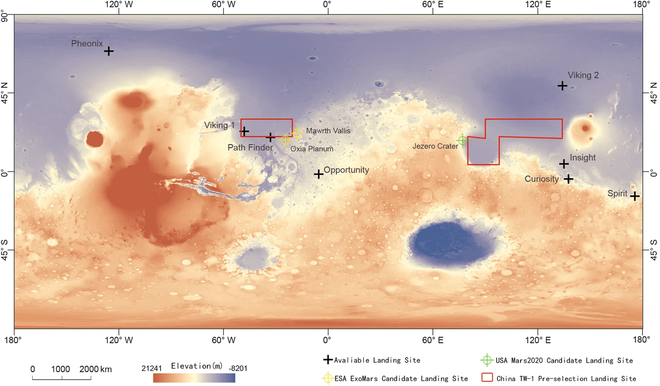
The landing[edit]

At 23:18 UTC, on 14 May 2021, theTianwen-1 lander successfully landed in the preselected landing area in the southern part of the MarsUtopia Planitia.[12][65]The landing phase began with the release of the protective capsule containing the lander/rover. The capsule made anatmospheric entryfollowed by a descent phase under parachute, after which the lander usedretro-propulsionto soft-land on Mars.[13][14][65]
On 19 May 2021, CNSA released for the first time images showing the preparation of the final transfer of theZhurongrover from the platform of the lander to the Martian soil. The photographs show the solar panels ofZhurongalready deployed whileZhurongis still perched on the lander along with two circular windows on the deck under which n-undecane was stored in 10 containers that absorbs heat and melts during the daytime and solidifies and releases heat at night.[66][53][54]The long delay for the publication of the first images is explained by the short periods of time when theZhurongrover and the orbiter are in radio contact and can effectively communicate and transfer data.[67]
On 11 June 2021, CNSA released the first batch of scientific images from the surface of Mars including a panoramic image taken byZhurongand a group photo ofZhurongand theTianwen-1 lander taken by the drop camera. The panoramic image is composed of 24 single shots taken by the NaTeCam before the rover was deployed to the Martian surface. The image reveals that the topography and rock abundance near the landing site was consistent with previous anticipations from the scientist on typical southUtopia Planitiafeatures with small but widespread rocks, white wave patterns, and mud volcanoes.[20]
Exploration of Martian surface[edit]

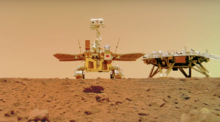
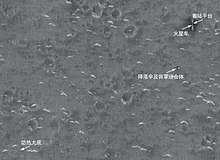
On 22 May 2021 (02:40 UTC), theZhurongroverdescended from its lander onto the Martian surface to begin its scientific mission. The first images received on Earth after the rover deployment showed the empty landing platform and the extended rover-descent ramps.[29][30]During its deployment, the Rover's instrument, Mars Climatic Station, recorded the sound, acting as the second martian sound instrument to record Martian sounds successfully afterMars 2020Perseverance rover's microphones.
TheZhurongrover deployed a drop camera to the surface which was able to photograph both theZhurongrover and theTianwen-1 lander.[35] The rover is designed to explore the surface for 90sols;its height is about 1.85 m (6.1 ft) and it has a mass of about 240 kg (530 lb). After the rover deployment, the orbiter would serve as a telecommunications relay for the rover while continuing to conduct its own orbital observations of Mars.[68]
On 12 July 2021,Zhurongvisited the parachute and backshell dropped onto the Martian surface during its landing on 14 May.[69][70]
On 15 August 2021,Zhurongofficially completed its planned exploration tasks and will continue to drive towards the southern part of Utopia Planitia where it landed.[71]On 18 August 2021,Zhurongoutlived its lifespan of 90 sols[72]and the Chinese scientists and engineers announced an extended expedition aiming to investigate an ancient coastal area on Mars.[73]
From mid-September to late October 2021, both theTianwen-1 orbiter andZhurongrover entered safe mode due to a communications blackout aroundsolar conjunction.[74]Both devices were back to active mode after the ending of the blackout.[75]
On 20 May 2022,Zhurongwas put into hibernation mode to prepare for the approaching sandstorms and Martian winter, and was programmed to self-awake at an appropriate temperature and sunlight condition.[76][77]
On 27 February 2023, the initial results of the meteorological data from the first 325 sols of the mission were published in the journalNature.[78]
Instruments[edit]
Scientific instruments[edit]
To achieve the scientific objectives of the mission, theTianwen-1 orbiter is equipped with eight scientific instruments, while theZhurongrover is equipped with six, which include:[63]
Orbiter[edit]



- Moderate Resolution Imaging Camera(MoRIC) with a resolution of 100 m from a 400 km altitude. It takes color photos in visible band.
- High Resolution Imaging Camera(HiRIC) with a resolution of 2.5 m from a 256 km altitude in panchromatic mode, 10 m in color mode.
- Mars Orbiter Magnetometer(MOMAG) is used to map Martian magnetic field.
- Mars Mineralogical Spectrometer(MMS) utilizes the visible and near infrared imagingspectrometerwith detection wavelengths ranging from 0.45 to 3.4 μm to investigate and analyze the Martian surface composition. It also investigate the distribution of regolith types and subsurface structure of Mars.
- Mars Orbiter Scientific Investigation Radar(MOSIR) aims to explore the Martian surface and subsurface water-ice by means of the dual-polarization echo characteristics of radar.
- Mars Ion and Neutral Particle Analyzer(MINPA) measures the flux of ions in space environment, distinguishes the main ions and obtains their physical parameters such as the density, velocity and temperature.
- Mars Energetic Particle Analyzer(MEPA) obtains the energy spectrum, flux and elemental composition of energy electrons, protons, α particles and ions.
- Unknown payload, likely theMars Orbiter Status Monitoring Sensor (MOSMOS),to monitor and evaluate the condition of key components, the Chinese flag and the2022 Winter OlympicsandParalympicslogo on the orbiter. The selfie rod, 0.8 kg (1.8 lb) in weight and 1.6 m (5 ft 3 in) long, is made from shape memory composite material, solar heat makes it extended to working position with two cameras fixed at one end and attached to orbiter on another end along with some degrees of freedom to the arm.[79][80][81][82]
Zhurongrover[edit]

- Mars Rover Penetrating Radar(RoPeR)Ground-penetrating radar(GPR), two frequencies, to image about 100 m (330 ft) below the Martian surface[31]It was one of the two very first ground-penetrating radars deployed on Mars, along with the one equipped byNASA'sPerseveranceroverlaunched and landed in same years.[83]
- Mars RoverMagnetometer(RoMAG) obtains the fine-scale structures of crustal magnetic field based on mobile measurements on the Martian surface.
- Mars Climate Station(MCS) (alsoMMMIMars Meteorological Measurement Instrument) measures the temperature, pressure, wind velocity and direction of the surface atmosphere, and a microphone to capture Martian sounds. During rover's deployment, it recorded the sound, acting as the second Martian sound instrument to record Martian sounds successfully afterMars 2020Perseverance rover's microphones.
- Mars Surface Compound Detector(MarSCoDe) combineslaser-induced breakdown spectroscopy(LIBS) and infrared spectroscopy[84]
- Multispectral Camera(MSCam) Combined with MarSCoDe, MSCam investigates the mineral components to establish the relationship between Martian surface water environment and secondary mineral types, and to search for historical environmental conditions for the presence of liquid water.
- Navigation and Topography Cameras(NaTeCam) With 2048 × 2048 resolution, NaTeCam is used to construct topography maps, extract parameters such as slope, undulation and roughness, investigate geological structures, and conduct comprehensive analysis on the geological structure of the surface parameters.
Lander[edit]
The lander did not have a scientific payload, but carried aMars Emergency Beacondesigned to survive the force of a catastrophic crash. The beacon would have allowed critical engineering data to be collected to aid future design.[85]The lander also carried the Chinese flag and2022 Winter Olympics and Paralympics mascotswith it like the orbiter.
Other instruments[edit]
- Tianwen-1 Deployable Cameras,two secondary Payloads deployed in September 2020 in deep space and 31 December 2021 in Mars orbit respectively, that took photos of and tested a radio connection withTianwen-1.[11]The first camera's mission was to photograph theTianwen-1 orbiter and the lander's heat shield while the other one had to image the orbiter and Northern Mars Ice Cap from Mars orbit.
- Tianwen-1 Remote Camera,secondary Payload deployed on 1 June 2021 that took photos of and tested a wireless connection withZhurongrover like the deployable cameras did with orbiter. Its mission was to take a group selfie of theZhurongrover and theTianwen-1 lander.[86]The photo was released on 11 June 2021, confirming their Martian landing success.[20]
International collaborations[edit]
Argentina'sComisión Nacional de Actividades Espaciales(CONAE) is collaborating onTianwen-1 by way of theEspacio Lejano tracking stationinstalled inLas Lajas, Neuquén.The facility played a previous role in China's landing of theChang'e 4spacecraft on the far side of theMoonin January 2019.[87]
France'sInstitut de Recherche en Astrophysique et Planétologie(IRAP) inToulouse,in France, is collaborating on theZhurongrover.Sylvestre Mauriceof IRAP said:
For their Laser Induced Breakdown Spectroscopy (LIBS) instrument, we have delivered a calibration target that is a French duplicate of a target which is on [NASA's]Curiosity[Mars rover]. The idea is to see how the two datasets compare.[87]
TheAustrian Research Promotion Agency(FFG) aided in the development of a magnetometer installed on theTianwen-1 orbiter. The Space Research Institute of theAustrian Academy of SciencesinGrazhas confirmed the group's contribution to theTianwen-1 magnetometer and helped with the calibration of the flight instrument.[87]
While theTianwen-1 orbiter will dispense commands to theZhurongrover, theMars Expressorbiter of theEuropean Space Agencycould serve as a backup.[88]

See also[edit]
- Astrobiology– Science concerned with life in the universe
- Climate of Mars
- Chinese Deep Space Network
- Exploration of Mars
- ESTRACK
- List of missions to Mars
- Life on Mars– Scientific assessments on the microbial habitability of Mars
- Emirates Mars Mission,UAE 2020 Mars mission with itsHopeorbiter
- Mars sample-return mission– Mars mission to collect rock and dust samples
Notes[edit]
- ^The United Kingdom'sBeagle 2,part of theEuropean Space Agency'sMars Expressmission, appears to have landed successfully, but was unable to establish communications after failing to fully deploy itssolar panels.[27][28]
References[edit]
- ^"Trung Quốc hoả tinh dò xét khí lộ chân dung sang năm phóng ra".Ta Kung Pao(in Chinese). 12 October 2019.Archivedfrom the original on 16 December 2019.Retrieved19 June2021.
- ^The Global Exploration Roadmap(PDF).International Space Exploration Coordination Group. January 2018.Archived(PDF)from the original on 27 November 2018.Retrieved13 December2018.
 This article incorporates text from this source, which is in thepublic domain.
This article incorporates text from this source, which is in thepublic domain.
- ^Wang, F. (2018).China's Cooperation Plan on Lunar and Deep Space Exploration(PDF).United Nations Office for Outer Space Affairs.Archived(PDF)from the original on 14 February 2019.Retrieved19 June2020.
- ^abc"China Exclusive: China's aim to explore Mars".Xinhua News Agency. 21 March 2016. Archived fromthe originalon 26 March 2016.Retrieved24 March2016.
- ^"China breaks silence over status of Mars rover Zhurong".Al Jazeera.Retrieved24 March2024.
- ^"Tianwen-1".China National Space Administration (CNSA).Archivedfrom the original on 27 July 2020.Retrieved2 December2022.
- ^Thượng Hải vệ tinh (14 February 2021)."509 việc làm ngươi giải mật hoả tinh vờn quanh khí kết cấu thiết kế!"(in Simplified Chinese).Archivedfrom the original on 17 January 2023.Retrieved17 January2023.
- ^Wall, Mike (23 July 2020)."China launches ambitiousTianwen-1 Mars rover mission ".Space.Archivedfrom the original on 23 July 2020.Retrieved12 February2021.
- ^"Thiên hỏi nhất hào dò xét khí phi hành chặng đường đột phá 3 trăm triệu cây số"[Tianwen-1 has flown more than 300 million kilometres].cnsa.gov.cn(in Chinese). China National Space Administration. 17 November 2020.Archivedfrom the original on 17 November 2020.Retrieved12 January2021.
- ^abGebhardt, Chris (10 February 2021)."China, withTianwen-1, begins tenure at Mars with successful orbital arrival ".NASASpaceFlight.Archivedfrom the original on 10 February 2021.Retrieved10 February2021.
- ^abcdClark, Stephen (6 October 2020)."China's Mars-bound probe returns self-portrait from deep space".Spaceflight Now.Archivedfrom the original on 8 October 2020.Retrieved14 December2020.
- ^ab"Quốc gia của ta lần đầu hoả tinh dò xét nhiệm vụ chạm đất hoả tinh lấy được viên mãn thành công".cnsa.gov.cn(in Chinese). China National Space Administration. 15 May 2021.Archivedfrom the original on 15 May 2021.Retrieved15 May2021.
Nghiên cứu khoa học đoàn đội căn cứ "Chúc Dung hào" hoả tinh xe trở lại đo cự ly xa tín hiệu xác nhận, 5 nguyệt 15 ngày 7 khi 18
- ^ab"Thiên hỏi nhất hào thành công chạm đất hoả tinh!"(in Chinese). China News Service. 15 May 2021.Archivedfrom the original on 15 May 2021.Retrieved19 June2021.
- ^abZhang, Hang (15 May 2021)."Quan tuyên! 7 khi 18 phân!" Thiên hỏi nhất hào "Dò xét khí thành công chạm đất hoả tinh".Beijing Daily(in Chinese).Archivedfrom the original on 18 December 2021.Retrieved19 June2021.
- ^abcdJones, Andrew (28 October 2020)."China chooses landing site for itsTianwen-1 Mars rover ".Space.Archivedfrom the original on 29 October 2020.Retrieved16 November2020.
- ^Weitering, Hanneke (15 May 2021)."China's 1st Mars rover 'Zhurong' lands on the Red Planet ".Space.Archivedfrom the original on 15 May 2021.Retrieved16 May2021.
- ^abcdLiu, J.; Lai, C.; Zhang, R.; Rao, W.; Cui, X.; Geng, Y.; Jia, Y.; Hiang, H.; Ren, X.; Yan, W. (6 December 2021)."Geomorphic contexts and science focus of the Zhurong landing site on Mars".Nature Astronomy.6:65–71.doi:10.1038/s41550-021-01519-5.S2CID244931773.
- ^Hebden, Kerry (14 May 2021)."China is about to land itsZhurongrover on Mars ".Room.Archivedfrom the original on 15 May 2021.Retrieved16 May2021.
The same Chinese space watchers who revealed the impending descent also report thatZhurongwill begin exploration on 22 May
- ^""Chúc Dung hào" hoả tinh xe chuẩn bị qua đông vờn quanh khí liên tục khai triển vờn quanh dò xét "(in Simplified Chinese). Nhân dân võng. 6 May 2022.Archivedfrom the original on 6 May 2022.Retrieved6 May2022.
- ^abc"Thiên hỏi nhất hào dò xét khí chạm đất hoả tinh đầu phê khoa học hình ảnh đồ mở màn".cnsa.gov.cn(in Chinese). China National Space Administration. 11 June 2021.Archivedfrom the original on 11 June 2021.Retrieved12 June2021.
- ^ab"New Year's Day greetings-China National Space Administration releases the images returned by the Tianwen-1 probe".1 January 2022.Archivedfrom the original on 1 January 2022.Retrieved1 January2022.
- ^abMyers, Steven Lee; Chang, Kenneth (14 May 2021)."China's Mars Rover Mission Lands on the Red Planet".The New York Times.Archivedfrom the original on 26 October 2021.Retrieved16 May2021.
- ^abcJones, Andrew (23 July 2020)."Tianwen-1 launches for Mars, marking dawn of Chinese interplanetary exploration ".SpaceNews.Archivedfrom the original on 10 November 2022.Retrieved23 July2020.
- ^Roulette, Joey (5 February 2021)."Three countries are due to reach Mars in the next two weeks".The Verge.Archivedfrom the original on 5 February 2021.Retrieved7 February2021.
- ^Fitzsimons, Tim (15 May 2021)."China becomes only second nation in history to land a rover on Mars".NBC News.Archivedfrom the original on 15 May 2021.Retrieved8 November2022.
- ^Corbett, Tobias (14 May 2021)."China succeeds on country's first Mars landing attempt withTianwen-1 ".NASASpaceFlight.Archivedfrom the original on 14 May 2021.Retrieved15 May2021.
- ^Graham, William (13 March 2016)."Proton-M successfully launches first ExoMars spacecraft".NASASpaceFlight.Archivedfrom the original on 18 March 2016.Retrieved19 June2021.
- ^Goddard, Jacqui (13 February 2021)."US rover Perseverance will taste, touch and listen to Mars".The Times.Archivedfrom the original on 16 May 2021.Retrieved19 June2021.
- ^abWoo, Ryan; Sun, Yilei (22 May 2021)."China says Martian rover takes first drive on surface of Red Planet".Reuters.Archivedfrom the original on 22 May 2021.Retrieved22 May2021.
- ^ab"Chúc Dung hào hoả tinh xe thành công sử thượng hoả tinh mặt ngoài"[Zhurongrover successfully descended onto the surface of Mars] (in Chinese). Xinhua News Agency. 22 May 2021.Archivedfrom the original on 14 June 2021.Retrieved22 May2021.
- ^abcZhou, Bin; Shen, Shaoxiang; Ji, Yicai; Lu, Wei; Zhang, Feng; Fang, Guangyou; Su, Yan; Dai, Shun (2016). "The subsurface penetrating radar on the rover of China's Mars 2020 mission".2016 16th International Conference on Ground Penetrating Radar (GPR).2016 16th International Conference on Ground Penetrating Radar (GPR). Hong Kong, China. pp. 1–4.doi:10.1109/ICGPR.2016.7572700.ISBN978-1-5090-5181-6.S2CID306903.
- ^Williams, Matt (30 May 2021)."Zhurongis Rolling on Mars ".Universe Today.Archivedfrom the original on 30 May 2021.Retrieved31 May2021.
- ^Woo, Ryan (15 May 2021)."China completes historic Mars spacecraft landing".Reuters.Archivedfrom the original on 15 May 2021.Retrieved15 May2021.
- ^"On its first try, China's Zhurong rover hit a Mars milestone that took NASA decades".space. July 2021.Archivedfrom the original on 25 October 2021.Retrieved14 October2021.
- ^ab"Khoa học hình ảnh đồ mở màn, dùng một lần vòng quanh tuần! Quốc gia của ta lần đầu hoả tinh dò xét nhiệm vụ lấy được viên mãn thành công"[The scientific image map was unveiled, and it was a one-time tour! my country's first Mars exploration mission was a complete success].China Space News(in Chinese). 11 June 2021.Archivedfrom the original on 11 June 2021.Retrieved19 June2021– via WeChat.
The picture of the "touring group photo" shows the rover traveling about 10 meters south of the landing platform, releasing the separate camera installed at the bottom of the vehicle, and then retreating to the vicinity of the landing platform.
- ^"IAF WORLD SPACE AWARD: ACHIEVEMENTS OF THE TIANWEN-1 MISSION".International Astronautical Federation.Archivedfrom the original on 19 September 2022.Retrieved22 September2022.
- ^"China's Tianwen-1 Mars mission wins international space award".Space. 22 September 2022.Archivedfrom the original on 23 September 2022.Retrieved23 September2022.
- ^"Mars Alert: Why Three Spacecraft Must Leave For The Red Planet Within Weeks Or Miss Their Chance".Forbes.Archivedfrom the original on 7 December 2022.Retrieved30 September2020.
- ^"Trung Quốc lần đầu hoả tinh dò xét nhiệm vụ mệnh danh là" thiên hỏi nhất hào ""[China's first Mars exploration mission named "TianwenNo. 1 "].Beijing Daily(in Chinese). 24 April 2020.Archivedfrom the original on 15 May 2021.Retrieved30 April2021.
- ^"China's first Mars exploration mission namedTianwen-1 ".Xinhua News Agency. 24 April 2020. Archived fromthe originalon 7 May 2020.Retrieved24 April2020.
- ^abYeung, Jessie (10 February 2021)."Tianwen-1, China's mission to Mars, has entered orbit ".CNN.Archivedfrom the original on 11 February 2021.Retrieved12 February2021.
- ^"China's first Mars rover namedZhurong".Xinhua News Agency. 24 April 2021.Archivedfrom the original on 24 April 2021.Retrieved24 April2021.
- ^""Chúc Dung hào" vinh đăng đứng đầu bảng! Trung Quốc đầu chiếc hoả tinh xe toàn cầu chinh danh đầu phiếu kết thúc ".Hunan Today(in Chinese). 2 March 2021.Archivedfrom the original on 24 April 2021.
- ^Wu, Nan (24 June 2014)."Next stop – Mars: China aims to send rover to Red Planet within six years".South China Morning Post.Archivedfrom the original on 1 February 2016.Retrieved23 February2016.
- ^"Tianwen-1 (China's first Mars Exploration Mission) ".eoPortal.Archivedfrom the original on 10 February 2021.Retrieved19 June2021.
- ^abcJones, Andrew (8 November 2019)."China Says Its Mars Landing Technology Is Ready For 2020".IEEE Spectrum.Archivedfrom the original on 24 September 2020.Retrieved30 December2019.
- ^"CNSA invited embassies and media to witness hovering and obstacle avoidance test for Mars Lander of China's first Mars exploration mission".cnsa.gov.cn.China National Space Administration. 14 November 2019.Archivedfrom the original on 23 May 2021.Retrieved23 May2021.
- ^Zhao, Lei (24 April 2020)."China's first Mars mission namedTianwen1 ".China Daily.Archived fromthe originalon 25 January 2021.Retrieved22 May2021.
- ^"China's Mars probe completes deep-space maneuver".Xinhua News Agency. 10 October 2020.Archivedfrom the original on 14 May 2021.Retrieved10 October2020.
- ^abJones, Andrew (10 February 2021)."China'sTianwen-1 enters orbit around Mars ".SpaceNews.Archivedfrom the original on 10 February 2021.Retrieved12 February2021.
- ^Zhao, Lei (29 July 2020)."Mars probe begins science operations".China Daily.Archivedfrom the original on 13 February 2021.Retrieved12 February2021.
- ^"Update: China'sTianwen-1 probe sends back Mars landing visuals ".Xinhua News Agency. 19 May 2021.Archivedfrom the original on 19 May 2021.Retrieved19 May2021.
- ^abRoulette, Joey (19 May 2021)."China releases first images from itsZhurongrover on Mars ".The Verge.Archivedfrom the original on 19 May 2021.Retrieved19 May2021.
- ^abAmos, Jonathan (19 May 2021)."China on Mars:Zhurongrover returns first pictures ".BBC News.Archivedfrom the original on 19 May 2021.Retrieved19 May2021.
- ^Jones, Andrew (14 May 2021)."China'sZhurongMars rover lands safely in Utopia Planitia ".SpaceNews.Retrieved18 May2021.
- ^Jia, Yingzhuo; Fan, Yu; Zou, Yongliao (2018)."Scientific Objectives and Payloads of Chinese First Mars Exploration"(PDF).Space Science Activities in China: National Report 2016–2018 (Report). pp. 101–105.Archived(PDF)from the original on 3 March 2021.Retrieved13 July2020.
- ^Normile, Dennis (25 June 2020)."Mars mission would put China among space leaders".Science.368(6498): 1420.Bibcode:2020Sci...368.1420N.doi:10.1126/science.368.6498.1420.PMID32587004.S2CID220077904.Archivedfrom the original on 21 October 2021.Retrieved12 February2021.
- ^Lozovschi, Alexandra (17 January 2019)."China Plans To Land A Rover On Mars In 2020".Inquisitr.Archivedfrom the original on 24 September 2020.Retrieved16 May2021.
- ^Zhao, Lei (3 December 2019)."Country making strides toward Mars mission".China Daily.Archivedfrom the original on 15 March 2020.Retrieved12 February2021.
- ^Jones, Andrew (5 January 2021)."China'sTianwen-1 spacecraft will reach Mars orbit on 10 February 2021 ".Space.Archivedfrom the original on 11 February 2021.Retrieved12 February2021.
- ^Amos, Jonathan (10 February 2021)."China Mars mission:Tianwen-1 spacecraft enters into orbit ".BBC News.Archivedfrom the original on 10 February 2021.Retrieved10 February2021.
- ^Daniel Estévez (10 November 2021)."Tianwen-1 remote sensing orbit".Archivedfrom the original on 8 March 2021.Retrieved11 November2021.
- ^abcLi, Chunlai; Zhang, Rongqiao; Yu, Dengyun; Dong, Guangliang; Liu, Jianjun; Geng, Yan; Sun, Zezhou; Yan, Wei; Ren, Xin; Su, Yan; Zuo, Wei; Zhang, Tielong; Cao, Jinbin; Fang, Guangyou; Yang, Jianfeng; Shu, Rong; Lin, Yangting; Zou, Yongliao; Liu, Dawei; Liu, Bin; Kong, Deqing; Zhu, Xinying; Ouyang, Ziyuan (June 2021)."China's Mars Exploration Mission and Science Investigation".Space Science Reviews.217(4): 57.Bibcode:2021SSRv..217...57L.doi:10.1007/s11214-021-00832-9.
- ^abcdeWu, Bo; Dong, Jie; Wang, Yiran; Rao, Wei; Sun, Zezhou; Li, Zhaojin; Tan, Zhiyan; Chen, Zeyu; Wang, Chuang; Liu, Wai-Chung; Chen, Long; Zhu, Jiaming; Li, Hongliang (April 2022)."Landing site selection and characterization of Tianwen-1 (Zhurong rover) on Mars".Journal of Geophysical Research: Planets.127(4).Bibcode:2022JGRE..12707137W.doi:10.1029/2021JE007137.
- ^abAmos, Jonothan (15 May 2021)."China lands itsZhurongrover on Mars ".BBC News.Archivedfrom the original on 15 May 2021.Retrieved16 May2021.
- ^Tianwen-1 | Deep Space Exploration of China [@CNDeepSpace] (5 January 2022)."The secret keeping #Zhurong warm during freezing night is under the two circular windows: N-undecane stored in 10 containers absorbs heat and melts during the daytime and solidifies and releases heat at night. https://t.co/UBT9fD94bw"(Tweet).Archivedfrom the original on 5 January 2022.Retrieved21 February2022– viaTwitter.
{{cite web}}:CS1 maint: numeric names: authors list (link) - ^Barthélémy, Pierre (19 May 2021)."Le rover chinoisZhurongenvoie ses premières photos de Mars "[The Chinese roverZhurongsends its first photographies].Le Monde(in French).Archivedfrom the original on 19 May 2021.Retrieved19 May2021.
- ^Wall, Mike (17 May 2021)."China's newly landed Mars roverZhuronglikely to roll into action this weekend ".Space.Archivedfrom the original on 24 June 2021.Retrieved17 May2021.
- ^""Chúc Dung hào" gần gũi "Xem" dù để nhảy cùng bối tráo ".CNSA(in Chinese). 16 July 2021.Archivedfrom the original on 14 November 2021.Retrieved21 July2021.
- ^Jones, Andrew (15 July 2021)."China's Zhurong Mars rover visits own parachute".SpaceNews.Retrieved21 July2021.
- ^"China's rover travels over 1 km on Mars".China Daily.Xinhua News Agency. 23 August 2021.Archivedfrom the original on 30 August 2021.Retrieved30 August2021.
- ^Jones, Andrew (30 July 2021)."China's Zhurong Mars rover scopes out dunes on journey south".Space.Archivedfrom the original on 5 May 2023.Retrieved14 March2023.
- ^Kooser, Amanda (20 August 2021)."China's Mars rover outlasts its life expectancy, keeps on going".CNET.Archivedfrom the original on 14 March 2023.Retrieved14 March2023.
- ^Jones, Andrew (5 September 2021)."China's Zhurong Mars rover returns panorama ahead of planetary blackout".Space.Archivedfrom the original on 4 December 2021.Retrieved4 December2021.
- ^Jones, Andrew (22 October 2021)."China's Zhurong Mars rover returns panorama ahead of planetary blackout".Space.Archivedfrom the original on 13 November 2021.Retrieved4 December2021.
- ^Mallapaty, Smriti (20 January 2023)."What's happened to China's first Mars rover?".Nature.doi:10.1038/d41586-023-00111-3.PMID36670252.S2CID256056375.Archivedfrom the original on 10 February 2023.Retrieved10 February2023.
- ^Kooser, Amanda."China's First Mars Rover May Have Run Into Trouble on the Dusty Planet".CNET.Archivedfrom the original on 10 February 2023.Retrieved10 February2023.
- ^Jiang, Chunsheng; Jiang, Yu; Li, Hengnian; Du, Sen (27 February 2023)."Initial results of the meteorological data from the first 325 sols of the Tianwen-1 mission".Nature.13(1): 3325.Bibcode:2023NatSR..13.3325J.doi:10.1038/s41598-023-30513-2.PMC9971204.PMID36849722.S2CID257208512.
- ^Tianwen-1 | Deep Space Exploration of China [@CNDeepSpace] (31 January 2022)."Correction: the stick that I thought to be the selfie stick (MOSMOS) is actually the 3rd Scientific Investigation Radar (MOSIR). The selfie stick should locate at the lower right as shown in the red circle in this attached photo. It seems not deployed yet when the photo was taken https://t.co/a9SupzjrnD"(Tweet).Archivedfrom the original on 31 January 2022.Retrieved21 February2022– viaTwitter.
{{cite web}}:CS1 maint: numeric names: authors list (link) - ^Tianwen-1 | Deep Space Exploration of China [@CNDeepSpace] (30 January 2022)."Classic way of taking selfie. Tianwen-1 deploys a selfie stick that is made out of shape memory composite. It weighs only 0.8kg and extends to 1.6 meters long. In this video, the folded stick was heated after Mars orbit insertion, and it automatically extended #Zhurong #Tianwen1 https://t.co/qobX0FeulZ"(Tweet).Archivedfrom the original on 31 January 2022.Retrieved21 February2022– viaTwitter.
{{cite web}}:CS1 maint: numeric names: authors list (link) - ^Tianwen-1 | Deep Space Exploration of China [@CNDeepSpace] (30 January 2022)."Here is how the selfie stick looks in folded state. How many secrets do #Tianwen1 have that we don't know yet? #Zhurong update: 1524 meters driving distance after 255 sols as of Jan.31 # thiên hỏi nhất hào # Chúc Dung hào hoả tinh xe https://t.co/llkBKNp9Ft"(Tweet).Archivedfrom the original on 31 January 2022.Retrieved21 February2022– viaTwitter.
{{cite web}}:CS1 maint: numeric names: authors list (link) - ^Tianwen-1 | Deep Space Exploration of China [@CNDeepSpace] (9 February 2022)."The cameras #Tianwen1 used for selfies. https://t.co/3WWqalmuEd"(Tweet).Archivedfrom the original on 9 February 2022.Retrieved21 February2022– viaTwitter.
{{cite web}}:CS1 maint: numeric names: authors list (link) - ^Jones, Andrew (22 July 2020)."China raises the stakes with second Mars attempt".SpaceNews.Retrieved1 July2021.
- ^Zou, Yongliao; Zhu, Yan; Bai, Yunfei; Wang, Lianguo; Jia, Yingzhuo; Shen, Weihua; Fan, Yu; Liu, Yang; Wang, Chi; Zhang, Aibing; Yu, Guobin; Dong, Jihong; Shu, Rong; He, Zhiping; Zhang, Tielong; Du, Aimin; Fan, Mingyi; Yang, Jianfeng; Zhou, Bin; Wang, Yi; Peng, Yongqing (2021)."Scientific objectives and payloads of Tianwen-1, China's first Mars exploration mission".Advances in Space Research.67(2): 812–823.Bibcode:2021AdSpR..67..812Z.doi:10.1016/j.asr.2020.11.005.ISSN0273-1177.
- ^"Vì thiên hỏi nhất hào trang thượng" sẽ gọi điện thoại hộp đen "".Nhân dân võng.17 May 2021.Archivedfrom the original on 31 August 2021.Retrieved31 August2021.
- ^Hoả tinh lúc sau chúng ta sẽ đi nơi nào? | 《 hoả tinh tới 》 đệ tam quý đệ ⑨ tập(in Chinese). China National Space Administration. 11 June 2021.Archivedfrom the original on 11 June 2021.Retrieved11 June2021– via Bilibili.
- ^abcDavid, Leonard (22 July 2020)."China'sTianwen-1 Mars rover mission gets a boost from international partners ".Space.Archivedfrom the original on 25 July 2020.Retrieved10 September2020.
- ^O'Callaghan, Jonathan (14 May 2021)."China LandsTianwen-1 Rover on Mars in a Major First for the Country ".Scientific American.Archivedfrom the original on 24 June 2021.Retrieved18 May2021.










